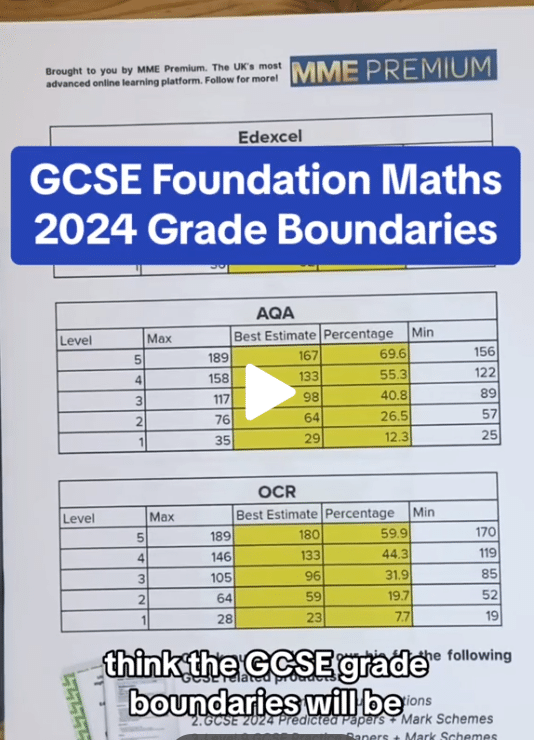Rules of Indices
Rules of Indices Revision
Indices Rules
Indices Rules builds on the 7 rules from Powers and Roots. We will cover 3 more complicated rules here. Make sure you are confident with the following topics before moving onto laws and indices.
Indices Rule 8: Fractional Powers
The fractional indices laws apply when the power is a fraction.
\textcolor{red}{a}^{\large{\frac{\textcolor{blue}{b}}{\textcolor{limegreen}{c}}}} = \sqrt[\textcolor{limegreen}{c}]{\textcolor{red}{a}^\textcolor{blue}{b}}
This is commonly use to show square and cube roots.
\textcolor{red}{x}^{\large{\frac{\textcolor{limegreen}{1}}{\textcolor{blue}{2}}}}= \sqrt[\textcolor{blue}{2}]{\textcolor{red}{x}^\textcolor{limegreen}{1}} =\sqrt[\textcolor{blue}{2}]{\textcolor{red}{x}}
\textcolor{red}{x}^{\large{\frac{\textcolor{limegreen}{1}}{\textcolor{blue}{3}}}}= \sqrt[\textcolor{blue}{3}]{\textcolor{red}{x}^\textcolor{limegreen}{1}} =\sqrt[\textcolor{blue}{3}]{\textcolor{red}{x}}
Note: it doesn’t matter which order you carry out the square root and multiplication operations. In other words, the rule can also be written as
\textcolor{red}{a}^{\large{\frac{\textcolor{blue}{b}}{\textcolor{limegreen}{c}}}} = (\sqrt[\textcolor{limegreen}{c}]{\textcolor{red}{a}})^\textcolor{blue}{b}
You should try to carry out the operations in the order that makes the calculation as simple as possible.
Indices Rule 9: Multi-step Fractional Powers
You may also be asked to simplify expressions where the numerator is not \bf{1}.
\textcolor{red}{64}^{\large{\frac{\textcolor{limegreen}{2}}{\textcolor{blue}{3}}}}= \sqrt[\textcolor{blue}{3}]{\textcolor{red}{64}^\textcolor{limegreen}{2}}
\sqrt[\textcolor{blue}{3}]{\textcolor{red}{64}} = \textcolor{red}{4}
\textcolor{red}{4}^\textcolor{limegreen}{2} = \textcolor{red}{16}
Indices Rule 10: Negative Powers
Negative powers flip the fraction and put 1 over the number
In general, the result of a negative power is “\bf{1} over that number to the positive power”, i.e.
\textcolor{red}{a}^{-\textcolor{limegreen}{b}} = \dfrac{1}{\textcolor{red}{a}^\textcolor{limegreen}{b}}
for any value of a or b. When the power is \textcolor{blue}{-1}, this takes the form,
\textcolor{red}{a}^{\textcolor{blue}{-1}}=\dfrac{1}{\textcolor{red}{a}} or \textcolor{red}{10}^{\textcolor{blue}{-1}} = \dfrac{1}{\textcolor{red}{10}}
When the number is a fraction, the negative power flips the fraction.
\bigg(\dfrac{\textcolor{blue}{a}}{\textcolor{limegreen}{b}}\bigg)^{-\textcolor{red}{x}} = \bigg(\dfrac{\textcolor{limegreen}{b}}{\textcolor{blue}{a}}\bigg)^\textcolor{red}{x}
Example 1: Negative Powers
Simplify the following, 4^{-3}.
[2 marks]
We now know that 4^{-3} is equal to \dfrac{1}{4^3}. We also know that
4^3=4\times 4\times 4=16\times 4=64.
So, we get that
4^{-3}=\frac{1}{64}.
Example 2: Fractional Powers and Roots
Simplify the following, 9^{\frac{3}{2}}.
[2 marks]
So, we know that 9^{\frac{3}{2}} is equal to \sqrt[2]{9^3} or (\sqrt[2]{9})^3.
So, to work out (\sqrt[2]{9})^3, we first have to square root 9, which is easy enough – the square root of 9 is 3. So, (\sqrt[2]{9})^3 becomes 3^3, which is
3^3=3\times 3\times 3 = 27
Example 3: Multiplication and Powers
Write 2^{15}\times 8^{-4} as a power of 2, and hence evaluate the expression. (Non calculator)
[3 marks]
The first part of the expression is a power of 2, whilst the second part is a power of 8.
we know that
8 = 2^3
This means we can rewrite the following,
8^{-4}=\left(2^3\right)^{-4}
Next, using Rule 3, we can simplify,
\left(2^3\right)^{-4}=2^{3\times(-4)}=2^{-12}
So the whole expression can be written as
2^{15}\times2^{-12},
Finally using Rule 1 we simplify the expression further.
2^{15}\times2^{-12}=2^{15+(-12)}=2^3
Thus, we have written the expression as a power of 2. Evaluating this final answer gives
2^3 = 8
Rules of Indices Example Questions
Question 1: Write 9^5\times3^{-5} as a power of 3
[3 marks]
So, we can’t use any laws straight away since the terms don’t have the same base. However, if we recognise that 9=3^2, then we can write the first term as
\left(3^2\right)^5
Using the power law, we get
\left(3^2\right)^5=3^{2\times5}=3^{10}
Therefore, the whole expression becomes
3^{10}\times3^{-5}
Applying the multiplication law, this simplifies to
3^{10+(-5)}=3^5
Thus, we have written the expression as a power of 3.
Question 2: Work out \sqrt{9}\times 6^{-2}
Write your answer in its simplest form (Non-calculator)
[3 marks]
Firstly, as 3^2=9, the inverse operation gives, \sqrt{9}=3
So, that leaves 6^{-2}, this becomes the following fraction,
6^{-2}=\dfrac{1}{6^2}
We know that 6^2=6\times 6=36, so
6^{-2}=\dfrac{1}{36}
Multiplying our two answers together, we get
\sqrt{9}\times 6^{-2}=3\times\dfrac{1}{36}=\dfrac{3}{36}=\dfrac{1}{12}
Question 3: Work out 4^{\frac{1}{2}}\times4^{\frac{3}{2}}
[3 marks]
This expression can be rewritten as,
\sqrt4 \times (\sqrt4)^3
Given we know that \sqrt4=2 , this becomes,
2\times2^3
Hence,
2\times2^3=2\times8=16
Notice that in this example we chose to perform the \sqrt{4} operation before cubing the answer. We could alternatively write the expression as \sqrt{4^3}, but in this case the first option is easier.
Question 4: Work out 8^{-\frac{5}{3}} (HIGHER ONLY)
(Non-calculator)
[3 marks]
As it is a negative power we can rewrite this as,
8^{-\frac{5}{3}}=\frac{1}{8^{\frac{5}{3}}}
Now, we can work out the denominator, which we will write as,
8^{\frac{5}{3}}=\sqrt[3]{8^5}=(\sqrt[3]{8})^5
We know that \sqrt[3]{8}=2. So this simplifies to,
(\sqrt[3]{8})^5=2^5
Counting up in powers of 2: 4, 8, 16, 32 – we see that 32 is the 5th power of 2, so
\sqrt[3]{8}^5=32
Therefore, the answer is,
8^{-\frac{5}{3}}=\dfrac{1}{32}






